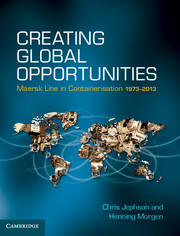Book contents
- Frontmatter
- Dedication
- Contents
- List of figures
- List of tables
- List of Economist Intelligence Unit data
- List of boxes
- Acknowledgements
- Glossary
- Prologue
- 1 ‘Per Aspera Ad Astra’
- 2 The Coming Revolution
- 3 The Decision
- 4 Building the Base (1978–1984)
- 5 Planning the Next Steps (1984–1987)
- 6 Laying the Foundations for Expansion (1987–1990)
- 7 The 1990s
- 8 The Acquisition Trail (1992–1998)
- 9 1999 A Year of Developments and Acquisitions
- 10 Into the New Millennium (2000–2005)
- 11 P&O NedLloyd (2005–2007)
- 12 A New Strategy (2008–2013)
- Epilogue
- Notes and References
- Index
3 - The Decision
Taking Maersk Line into Containers
Published online by Cambridge University Press: 05 April 2014
- Frontmatter
- Dedication
- Contents
- List of figures
- List of tables
- List of Economist Intelligence Unit data
- List of boxes
- Acknowledgements
- Glossary
- Prologue
- 1 ‘Per Aspera Ad Astra’
- 2 The Coming Revolution
- 3 The Decision
- 4 Building the Base (1978–1984)
- 5 Planning the Next Steps (1984–1987)
- 6 Laying the Foundations for Expansion (1987–1990)
- 7 The 1990s
- 8 The Acquisition Trail (1992–1998)
- 9 1999 A Year of Developments and Acquisitions
- 10 Into the New Millennium (2000–2005)
- 11 P&O NedLloyd (2005–2007)
- 12 A New Strategy (2008–2013)
- Epilogue
- Notes and References
- Index
Summary
It was a question of one big step or none at all.
Mærsk Mc-Kinney Møller, at the inauguration of Pier 51 in Newark, New Jersey, 1975Facing the facts
Maersk Line started sailings on the Panama Line from ports on the US East Coast via the Panama Canal and Los Angeles to the Far East in 1928. However, it did not establish itself as a major player in the Pacific until after the Second World War. In its 1966 report, the Stanford Research Institute stated that regional trades were expected to change over the coming years and that Maersk Line was well positioned to meet this development. The numerous inter-Asia routes that had been in operation since the 1950s would prosper from the growing economies in the region, notably Taiwan, South Korea, Hong Kong and Singapore. In its 1969 report on the potential of the A.P. Moller Group, McKinsey outlined the position of the competing liner operators in the Pacific trade – Sea-Land, APL, NYK and Mitsui, among others. They were either considering containerisation or already preparing for the delivery of fully cellular container ships. Maersk Line lagged significantly behind in that specific trade.
In fact, in the autumn of 1968 Mærsk Mc-Kinney Møller and Maersk Line had already initiated internal evaluations and discussions with Kawasaki Kisen Kaisha, Maersk Line’s partner on the newly established Europe–Asia trade, to determine how to address the container challenge. The two partners were very much influenced by messages coming out of the Far Eastern Freight Conference (FEFC), where other members – those building container ships at shipyards in Europe and Asia – discussed rates and conditions for the transport of containers. The predictions made in 1966 by McKinsey were now being talked about across the table and were very much a fact of life. Maersk Line knew it had to respond.
- Type
- Chapter
- Information
- Creating Global OpportunitiesMaersk Line in Containerisation 1973–2013, pp. 50 - 83Publisher: Cambridge University PressPrint publication year: 2014



